
THE INVENTION OF THE SQUARE PIANO
A Review of some early German Tafelklaviere.
(NOTE: In pursuing this subject it is assumed that we all understand what is meant by 'square piano'. It must be rectangular, have a keyboard, hammers to sound the strings, and dampers to silence them when the key is released. At the end of this paper some thoughts will be offered on the superficially similar instruments that were made without dampers.)
Many writers claim that the square piano was invented in Germany before 1760. This hypothesis has been around since Victorian times — but there is little evidence to support it. Indeed, 'hypothesis' may be an inapprpopriate word, since those who persist in promulgating it (mostly patriotic Germans) are adamant that it must be true. Yet when I made expensive and time-consuming efforts to locate and examine early examples in Germany, or to locate some unequivocal documentary evidence showing that such instruments truly existed in the 1740s and 50s, I found nothing that any serious scholar could or should accept. My visits to Berlin, Hamburg, Nuremberg, Leipzig, Halle, and Vienna produced no evidence to suggest that any extant instruments had credible inscriptions before 1766.
Written histories building upon such claims have no solid foundations. Even the best cite no truly contemporary document, or any indisputable surviving piano. Instead, they rely on unverified, secondary sources – usually very poor ones. But, taking the best line of scholars: Hipkins (1885) relies on the Belgian Fétis, who in turn relies, like so many German authorities, on H.C.Koch's Musikalisches Lexikon of 1802. This is a general musical dictionary. Koch's statement is found under 'Fortbien'. He says that such instruments were invented by organ builder Christian Ernst Friederici of Gera about 1758. 'Proof?' No. Koch, though knowledgeable about music generally, had no specialist knowledge in the area of keyboard instruments and their history. This is plain to see if you turn over the page to read his next entry – 'Fortepiano'. You see immediately that he is relying on very imperfect information from Jacob Adlung whose Anleitung was published almost 50 years earlier — in 1758! (A coincidence?) Koch repeats Adlung, using almost identical words, and still, in 1802, fails to give credit to Cristofori as the inventor of the pianoforte! So, rely on him at your peril! If you can not rely on him, then Fétis and Hipkins, and all who come after, have built on poor foundations.
No square piano signed by Friederici has ever been produced to support Koch. 'Fortbiens' from his workshop certainly were 'square pianos' (using our modern terminology) but their existence cannot be confirmed until the early 1770s, when they were praised by C.P.E. Bach, and also mentioned in a letter from Leopold Mozart (who, as the owner of a Friederici harpsichord, admired his instruments generally). I suspect that if we ever identify a surviving square piano from Friederici's workshop it will turn out to be very like Zumpe's work, like so many 'square pianos' from the regions near Hanover in the 1770s. Certainly every Tafelklavier that I have been shown in Germany that bears any resemblance to Zumpe's model is not a precedent for his work: on the contrary, they are derivative. That they were clearly inspired by the London-made instruments is shown by the way they copy many non-essential features of Zumpe's work, such as ivory touch plates, guide pins in the hammers, and inscriptions on their nameboards that clearly mimic London products, even to the extent of copying the English 'Gothic' script). Such features indicate that these makers, though based in Germany, aimed to gain sales by replicating the very popular 'English' pianos (mostly made in London by German emigrants). Good examples of this practice are the pianos of Hubert of Ansbach, Steinbrüch in Gotha, and Krogmann in Hamburg — but there were many others.
Nevertheless, there are several divergent styles of 'square piano', not in any sense related to 'English' instruments, originating in widely separated regions of Germany. If the claim for German origins in or before 1760 is to be sustained, these other types need to be examined carefully. The possibility remains that some of these may have preceded Zumpe's earliest productions.
---------------------------------------------------------
First let us deal with the most famous example.
'Johannes Socher, 1742'
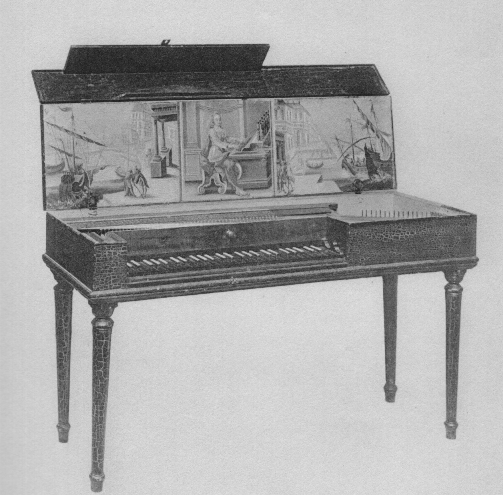
In 1925 instrument collector Paul de Wit's executors sold this piano to the Neupert family for their collection of historic instruments. When Rosamond Harding was researching for her Cambridge PhD in 1930 she visited Dr Hans Neupert and was shown this instrument. Consequently it appears in every edition of her very influential book, The Piano-forte: its History traced to the Great Exhibition, 1851, appearing as Plate VI, with the caption 'The oldest known example of a Square Piano, Johann Socher 1742'.
It is very unlikely that Harding understood what an extraordinary discovery this might be. If this claim were true it would be not only the oldest surviving square piano, but also the oldest known German-made piano of any kind. If made in 1742 it would pre-date every extant (grand) piano from Gottfried Silbermann's workshop. Yet this humble crudely-made Tafelklavier was apparently the work of an otherwise unknown village craftsman, in a provincial backwater in south-western Germany. Amazing!
What a discovery! If the date were true this would also be the world's oldest known piano with a sustaining stop, a distinction that would also have belonged to Silbermann. What an important instrument it might be.
It is now on exhibition at the Germanisches Nationalmuseum, in Nuremberg, and having carefully examined it twice, I am convinced it is a fraud. The date and putative maker's name can be seen on a paper label pasted very prominently on the soundboard. It reads: Joh. Socher im Obern Sonthofen Allgau. As you may see below, this is not written in the usual German script of the period, as seen in the handwriting of J.S.Bach and his contemporaries, but in very clear Italics — a surprising hand for a provincial craftsman in the 1740s. Then, spatially separated, in the border, we see the purported date 1742. Again this is not written in the usual script of that time but in a later style and with a crossed seven, something never seen in early eighteenth-century manuscripts. (Examine any musical manuscript of the period and see what kind of seven is used in the figured bass!) But let us suppose that this date with its inappropriate crossing of the seven was done by some over-zealous restorer, and proceed to consider other features.
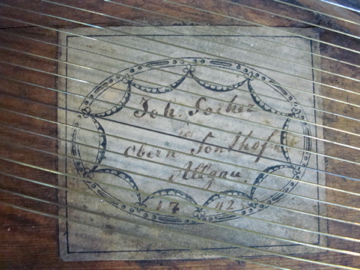
If it is very surprising to see this ticket pasted on an important active area of soundboard, it may be also remarked that Stewart Pollens in 'The Early Pianoforte' (1995) observed that there are visible old scratches in the surface of the wood next to it which do not continue on top of the label but pass under it. I can confirm that Pollens' observation is correct. The implication would appear to be obvious: this label was placed here long after the piano was made. The design of this label, with a characteristically fat oval with segmental divisions, is very much what might be expected from Vienna or South Germany between 1780 and 1810. A classical period label it could be: a baroque period label it is not! Notice also that Joh. Socher is not styled 'Musical Instrument maker' or anything similar. So a very probable explanation would be that the label was taken from some other item (not necessarily a musical instrument) and transferred to this soundboard in the late nineteenth or early twentieth century. From its appearance this ticket could have been taken from a book, for example. However, the soundboard is certainly old: probably eighteenth-century in origin. Note the wide spacing of the strings above this label: this instrument has a single string for each note. If you read elsewhere that it is bichord, as for example in Restle's doctoral thesis, don't believe it.
 The keyboard is old, but not credible. The brown, coniferous keylevers are straight (none of the treble keys are cranked to the left as is usual in clavichord or square piano design) and the balance rail is not angled, as would be expected, leading one to suspect that these keys may have been 'recycled' from an old harpsichord or fortepiano. Turn over the topmost key 'f' and you see a redundant notch that does not have any easy explanation, unless there was formerly an f sharp. It is also clear that these keys have been mounted (very badly) on a keyframe with a balance rail that is of much more recent manufacture. One can also see that the natural keys have been re-plated because the natural key heads are 45mm long, compared with an average of 36-38mm on genuine 18th-century German keyboards. Such re-plating was not uncommon c.1900. There is little about the hammer mechanism that inspires any confidence. The dampers, if they were genuine, would be the oldest surviving set of piano dampers from any German workshop. But let us not get bogged down in too much detail.
The keyboard is old, but not credible. The brown, coniferous keylevers are straight (none of the treble keys are cranked to the left as is usual in clavichord or square piano design) and the balance rail is not angled, as would be expected, leading one to suspect that these keys may have been 'recycled' from an old harpsichord or fortepiano. Turn over the topmost key 'f' and you see a redundant notch that does not have any easy explanation, unless there was formerly an f sharp. It is also clear that these keys have been mounted (very badly) on a keyframe with a balance rail that is of much more recent manufacture. One can also see that the natural keys have been re-plated because the natural key heads are 45mm long, compared with an average of 36-38mm on genuine 18th-century German keyboards. Such re-plating was not uncommon c.1900. There is little about the hammer mechanism that inspires any confidence. The dampers, if they were genuine, would be the oldest surviving set of piano dampers from any German workshop. But let us not get bogged down in too much detail.
Having examined this 'Socher' piano very carefully in 1993, when every reference book was citing this as the world's oldest square piano, and again in 1995, I have concluded that it is in fact a pastiche. It is an assembly of modern and antique components, that includes so many anachronisms that it does not merit any serious attention in the study of piano history — despite its inclusion in many books and websites. When you see this instrument cited as 'the world's oldest square piano' you may be sure that the writer has not studied the matter deeply.
A CAUTION: It is also important to point out that this instrument has no verifiable provenance. Paul de Wit sold so many very dubious specimens – his reputation is not unimpeachable, to put it mildly. He was also responsible for the 'discovery' of the upright piano now in Leipzig, inscribed 'A[nn]o. 1735' about which he was challenged by Kinsky when compiling his very careful catalogue in 1909. De Wit claimed that there was an inscription on the keys, and that the restorer must have over-written it, because it was faded. Kinsky, gave this no credit, adding a note next to the photogravure picture suggesting that this primitive upright piano dates from the third quarter of the eighteenth century. However, Harding seems not to have notice this, so it features in her book, Plate II(a) and Figure 19, with the caption 'Upright piano, 1735'. Let the reader beware!
Gottfried Silbermann, 1749
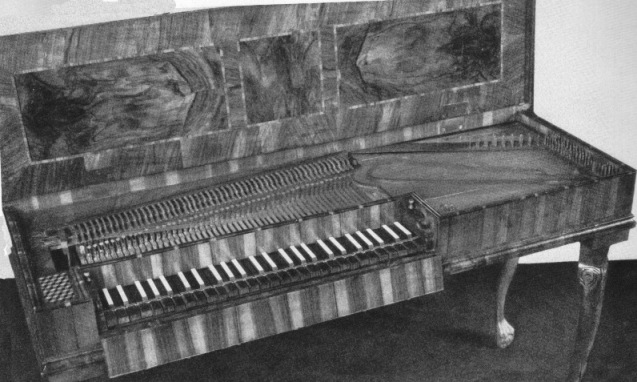
Apparently the next 'oldest' contender is in the Netherlands. The Gemeentenmuseum in The Hague has this early German-made 'square piano' ascribed to Gottfried Silbermann. Illustrated in Hirt, Meisterwerke des Klavierbaus (1955) this instrument has been seldom reported elsewhere, which is perhaps a good thing. It has a simple retro Prellmechanik hammer mechanism, similar to the Boos clavier (see below), and an unususal keyboard compass, C - e3. The keys also have a distinctive decoration, with twin lines of ivory inlaid in each ebony keyplate.
A paper label pasted inside the instrument purports to endorse it with a very famous name. It is torn at the corner but appears to read: ...fried Silbermann fecit 1749. The last two words have been read as Fev. 1749 by some who have examined it, but the year is clear enough — as it was intended to be. It is, however, spurious. This instrument is basically a genuine eighteenth-century Tafelklavier but it has been grossly over restored. It has been given a set of dampers, where it originally had none, and a bogus set of cabriole legs.
There are several old instruments of a very similar design, one of which I found in the basement store rooms of the Germanisches Nationalmuseum. It has the same action, the same unusual compass, and the same distinctive use of white inlaid lines across the keys. BUT, it has no dampers, and no fancy veneer work. In truth these two pianos are technically so similar that it ought to be possible, with enough time and effort, to make a coherent attribution and identification of the workshop from which they both came. All that can be said at present is that the label inside the above piano is not to be trusted. Gottfried Silbermann should not be credited with the invention of the square piano unless or until some real evidence is produced.
Franz Ignatz Seuffert, 1764
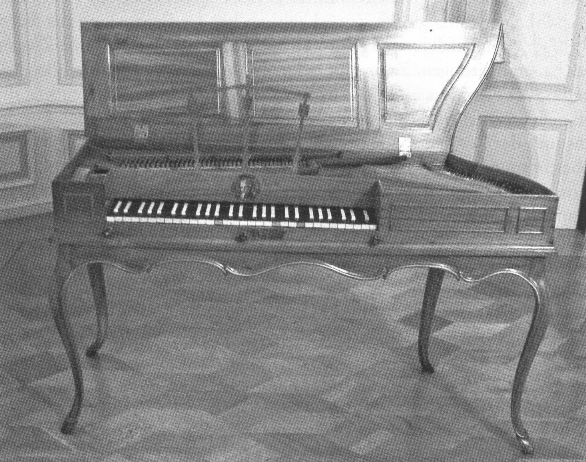
On display in the splendid Schloss Benrath, near Dusseldorf, we find this instrument, claimed to have been made in 1764. Grossly over-restored and much altered, it has inside at the left a pasted-down label with the following inscription: Franz: Ignat: Seuffert me fecit 1764 in Wien. [The underlining of the date makes no sense.] In support of the attribution to Seuffert there is some evidence, in the inscription of a privately-owned clavichord — the handwriting is very similar, and its date, 1761, is not underlined. The writing looks very similar.
Granted that all constructional details of the above piano are questionable, owing to the truly excessive modern rebuilding, and granted also that the hammer mechanism [retro Stossmechanik with escapement, well drawn by Harding as her Figure 31] dates from c.1790 or later, there is still a puzzle as regards the inscription. Franz Ignaz Seuffert was appointed organ and instrument maker to the Court in Wurzburg in 1760, in which post he continued for many years. So how he could be operating a workshop in Vienna ('in Wien') cannot be explained by anyone. The above-mentioned clavichord inscription does not include in Wien. It is all rather puzzling. If it truly was made in 1764 there is very little of that work remaining untouched. This instrument is not helpful in our search.
From its outward form and construction it is likely that it was originally concieved as a south German Pantalon (like many harp-shaped claviers attributed, doubtfully, to J. M. Schmahl of Ulm, c.1770) but whether in its original state it really was made by Seuffert in 1764, or whether it acquired a label taken from something else is impossible to determine. And why 'In Wien?' Without this label I and many others would have ascribed this instrument to a date c. 1780-95.
Conclusions
For the present, the oldest verified, dated square pianos are those signed by Johann (John) Zumpe in London. Of these there is no doubt whatever. Four of them survive that are clearly dated 1766, and there is also ample independent documentary evidence to support them. It is not impossible that he made some earlier than this, but any suggeston that he did so is speculation – which is exactly what we wish to avoid.
However, the archival researches by Prof Christian Ahrens (Ruhr University, Bochum) reveal that in October 1764 'Forte Piano Claviers' were advertised for sale in north Germany [Leipziger Zeitungen 3 Oct.1764 s.624]. Ahrens concludes that these must have been what we would now call 'square pianos' because one year later, in October 1765, in the same newspaper, giving the same address at Fregen's House, in Grimmischen Gasse, the advertiser says that he sells 'gute Forte Piano, Forte Piano Claviere, und ordinaire Claviere'. Interesting too, is his additional offer of Clavecins d'amour. In what did these differ from his Forte Piano Claviere? There is clearly a creative and enterprising dealer, and/or maker [or makers] behind this trail of documents, but we do not know any names or whether these instruments originated in Leipzig or were being sold as items of trade, made elsewhere. Unhappily, no connection can be established with any extant instrument, and no other pictorial or verbal details have been found to furnish a more exact description than is given in these newspaper notices.
Five-hundred kilometres south-west we find a notice inserted by the organ builder Johann Peter Senft in a Coblenz newspaper in November 1765 in which he offers 'Claviere auf die neueste Art Forte Piano betiteld ... [und] auch ordinaire kleinere Clavier'. [Johann Peter was the father of the better known Ignatz Senft of Augsburg.] So Johann Peter was apparently in 1765 making ordinary clavichords and also similar instruments called 'Forte Pianos'. The problem with interpreting this text is that Claviere auf die neueste Art could be read as 'keyboard instruments in the latest style, called Fortepianos'.
Prof. Ahrens argues further that the terminology Pantalon or Pantelong commonly used by instrument makers advertising in Hamburg during the period 1752-58 might include hammer-action instruments in rectangular form, but this cannot be verified. What we can say for sure is that when these Hamburg advertisers give any description or clues the instruments they are selling are in the outward form of a harpsichord or a clavicytherium [i.e. stehende Flugeln]. Prof Ahrens concedes that the 'Socher 1742' is not trustworthy, but tenaciously argues that, since he has 'proved' that there were Tafelklaviere in Leipzig in 1764, Zumpe may well have encountered something of this kind when making a return journey to his home town (near Nuremberg) some time between 1755 and 1766. Under this hypothesis he would then have returned to London and commenced production of a design that he has seen on his travels, claiming it as his own. This is unwarranted speculation. Prof. Ahrens is attempting to reconcile the dubious testimony of James Shudi Broadwood, written circa 1838, with his unshaken belief in the origins of Tafelklaviere in German. My response is that there is no evidence that Zumpe made any return visit to his home town before 1770, by which time he was already famous as the 'inventor of the small pianoforte'.
If anyone can report any other pre-1766 advertisements that cite Piano-fortes in rectangular form it would be a pleasure to report such texts, and give credit where it is due.
Boos and Kintzing
The earliest-dated extant 'square pianos' made in Germany are reckoned to be those by Christian Kintzing of Neuwied and J. A. Boos of Mainz. Both are dated 1767 on hand written labels and each has a simple retro Prellmechanik action with retro lever over dampers, similar to those shown by Dom Bedos de Celles (1778).
Christian Kintzing is reported to have settled in Neuwied in 1738. He was a Mennonite clock maker, associated from 1768 with David Roentgen, a well-known cabinet maker who had made a study tour in England in 1766 and whose output included writing desks that sometimes incorporated a piano keyboard (most likely these were special exhibition pieces). Kintzing's '1767' instrument is on display in the Red Room in the Kreismuseum, Neuwied (sorry no detailed picture available, but it can be seen there next to the longcase clocks [click]). It is not a standard square piano but a miniature instrument 42 inches wide (108 cm) with a keyboard of four octaves and a third from C. It would appear that this instrument has been subject to major alterations, not least because the treble part of the bridge is not sitting on free soundboard, but rests directly on the belly rail (or left hand support structure), which can only damage the tone. With such ill-considered interference one wonders whether the paper label pasted inside may be trusted. It reads: 1767 C. Kintzing @ Neuwied. [Personally, I find this very unconvincing. It looks like a nineteenth-century script.] The overall concept is a miniature lady's clavier, with a square-taper-legged stand, suggesting a date c.1790. So clearly this is not a piano in original condition from 1767. The action is a simple retro Prellmechanik with hammers that have hollow cylinder heads (like those shown by Dom Bedos in an organ-piano of 1772, by L'Epine). Kintzing's other attributed works include a clavichord with a Pantalon stop, so it is not unreasonable to query whether this 'square piano' may have been originally conceived as a Pantalon, within which the requisite 'Harfenzug' has been replaced by a set of dampers at a later date. There are many not unreasonable questions regarding this instrument.
There are problems of a different nature with regard to the Boos clavier. It is one of dozens of 'square pianos' in German museums that are clearly inspired by or made as clavichords, raising doubts as to whehter it began life as a clavichord. The picture below shows its general appearance.
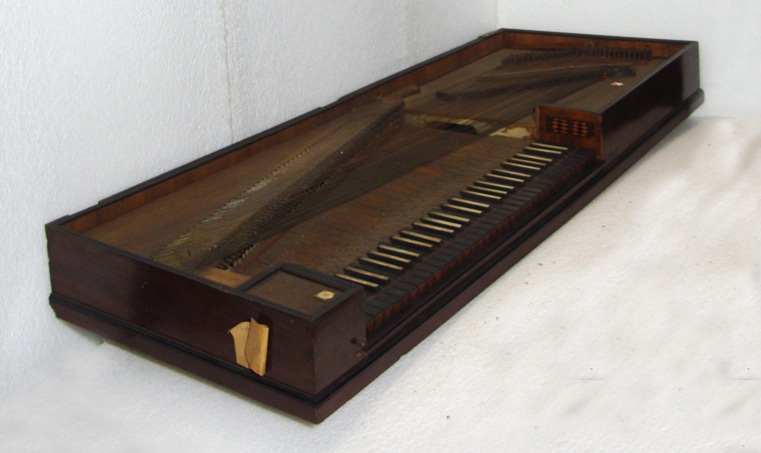
Photo: Michael Cole
Again, the attribution of this instrument [now in basemnt store at the Germanisches Nationalmuseum, Nuremberg] depends on a hand-written paper label inside. This label is shown below. (It has a 'nameboard' but without inscription, not shown in this photo. It is clearly of inferior quality, does not match any of the design features of the instrument itself, and is therefore not original.)
Photo: Michael Cole
The text reads fait. J: Ant: Boos faisseur des Clavecin et organiste de St: Pierre @ Mayence ao 1767 or in translation: made [by] J. Ant. Boos maker of harpsichord[s] and organist of St Pierre in Mainz, a[nn]o 1767.
The script looks very convincing.
Joseph Anton Boos, born 1727, the son of an organ builder, held several organist's posts in Mainz at various times, and has several surviving instruments to his credit. The above square piano is the earliest. On the whole this is a very well made instrument, in the western German tradition of clavichord making. The soundboard bridge is of low height, ebonised, and S-shaped. The dog-legged wrestpin array, the neatly cut ebonised cap mouldings on the case sides, and its overall height and proportions reflect the better class of work from masters like H A Hass of Hamburg. The keys too are carved in the alternating crest fashion typical of German clavichords from the 1760s. This was clearly a well-made instrument from a competent craftsman, but inevitably, the question arises: was this built as a fret free clavichord (after the Hamburg model) and then later converted to a pianoforte?
The restricted height available between the keys and the string band strongly suggest that it was conceived as a clavichord. Also, the keys are guided by an upright pin working in a notch cut in the rear of the key. This is a surprising choice for a Prellmechanik piano, and it should be observed that, though the pearwood Kapseln (in which the hammers pivot) are unusually small, nevertheless the rear of the keys had to be reduced in height to accommodate them (see photo below where the extra step lowers the height at which the hammer pivots). Any maker who set out to make such a piano would surely have planned sufficient space for this without having to chop into the keys to make them fit. Even so the result is a very shallow hammer stroke, and an awkwardly shallow key dip. The hammers themselves and the pearwood Kapseln are neatly fashioned, suggesting that this was not unfamiliar work to the maker, and they are similar to other makers' from the 1770s. Notice that the heads are connected to the hammer butts by metal stems, finely threaded at the end so as to make initial set up and subsequent adjustment easy. Most square pianos with such hammers were originally not covered with leather at the striking surface but struck with the bare wood, unless one were to draw the moderator stop which inserted little tabs of deerskin between the hammer and its strings, for a more dulcet tone. For more information about pianos with this type of action click here.
Photo: Michael Cole
The question still remains open — was this originally a clavichord, later converted to piano action? Or was Boos here engaged in experimental designs and inevitably making a few mistakes? There seems no reason to doubt the date and signature, but does the date 1767 refer to its original conception as a clavichord, or was it always fitted with hammers? My opinion is that it was made initially as a clavichord and afterwards converted, perhaps by Boos himself, about 1775-80.
Another Line of Investigation
Seeking for the origins of the square piano we might be better directing attention not to the middle Rhine area (where most of the instruments come from) but to northern Germany. Here there was a vogue for small rectangular keyboard instruments usually denominated Pantalon in archival records (with numerous variant spellings such as Bandalon, Pantalong and Pantaleon).[Click the blue text for more information on such instruments.] These were designed to reproduce the tonal effects and musical resources of Hebenstreit's famous gut-strung dulcimer, but with the convenience of playing them through a standard keyboard. A very important sub-class among them is distinguished by having two sets of hammers, replicating the beaters or mallets that Hebenstreit held in his hands. As with Hebenstreit's beaters these were equipped with different heads for contrasting tonal effects, suited to various music. One set was usually of bare wood (or some other hard material such as horn) producing a sparkling bright sound, while the alternate set of hammers, brought into play by a handstop, was tipped with soft leather to produce a dulcet tone. The player selected one or the other set according to the tonal requirements or Affect of the music. An important feature of such instruments is that they have no dampers. This was not due to the makers' incompetence. Such instruments were, to put it simply, conceived and played as keyboard dulcimers. The hammer mechanism is nearly always a simple intro Stossmechanik, similar in concept to Zumpe's pianos. Unhappily, none of these little Pantalons made in Germany has been found to have a dated inscription confirming its manufacture before 1770, though there are so many archival sources that mention Pantalons that one may suspect that at least some of them were keyboard instruments of small size.
However, a fascinating clue arose when a long-lost 'square piano' was discovered in England bearing the inscription of H. B. VIETOR, with the date 1767. Harman Bernard Vietor [or Viator] was at that date organist of a Lutheran church at the Savoy Chapel in London, but some sort of dispute arose about the validity of his appointment. Some members of the congregation were dissatisfied with Vietor and wanted a man named Baumgarten, so the election was re-run and Baumgarten won. Vietor may have been a competent organist, we don't know, and maybe a good music teacher, but unhappily he was NOT a professionally trained instrument maker. His sole surviving instrument exhibits poor craftsmanship and design. It is important to stress this because Rosamond Harding, who never saw an example of his work, suggests that Viator, before 1765, made [unspecified] improvements to the action of pianos, and some people have believed this. Nothing could be further from the truth. [Harding was, I believe, relying on the very questionable authority of Edward Rimbault, 1860].
Though the design and execution of this instrument is very imperfect, its interest as a historic specimen is greatly enhanced by Vietor's advertisements in London newspapers dating 1766 to 1768. In the earlier notices he names his instruments Coelestin d'Amour or 'Piano ex Forte'. In February 1768 however he boasts of his Forte Pianos in various sizes and constructions, of which he is the sole inventor! He also says that he 'has had the honour to sell a great many of them within the last seven years to a great part of the Nobility and Gentry in these kingdoms'. After allowing for some outrageous hyperbole we might conclude that Vietor had been making experimental hammer-action keyboard instruments before 1765, in London, and if so this implies that some similar instruments were made in northern Germany at least as early as 1761.
We can place beside him Frederick Neubauer (originally from Hamburg) who advertised Pantalon instruments in Hamburg newspapers from about 1754. He moved to London about 1756 and was advertising upright Pantalon instruments from 1763 onwards (sometimes under the name Clavecin de Amour [sic]) and other instruments, about which we know less. Some of these he named in 1765 as 'Pyano Fortes' (square pianos?). Nothing survives that can be identified with certainty as Neubauer's work, and it was presumed that we would have no better luck with Vietor until the instrument below was offered for sale at Piano Auctions in Red Lion Square.
H. B. Vietor, 1767
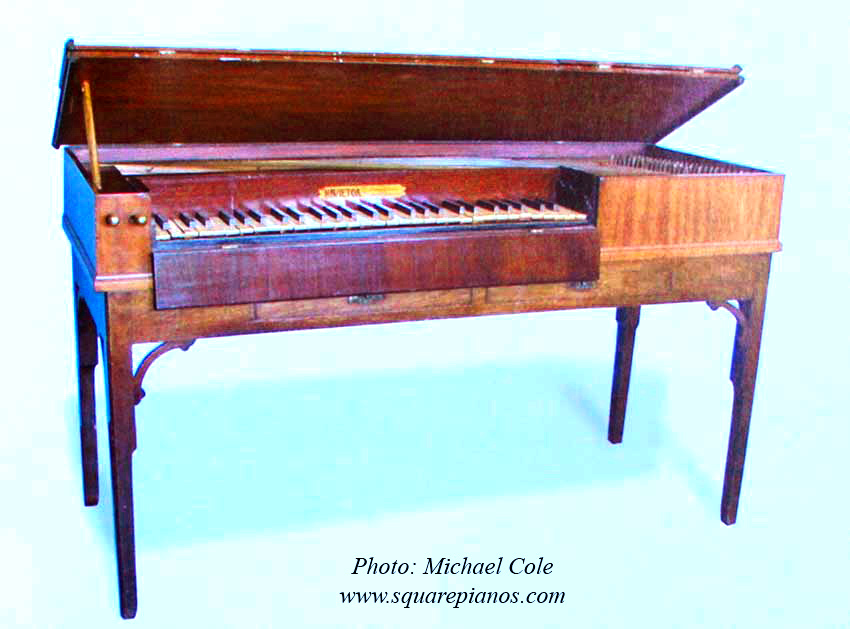
Photo: Michael Cole
Some points worth noting: the case is veneered in mahogany with vertically laid grain, very much in the style exhibited by Zumpe's square piano of 1767 in the Victoria & Albert Museum (seen in Grove's entry for Pianoforte and numerous other books). Sadly the museum has now closed its musical instruments gallery. Other resemblances to Zumpe's earliest pianos are the forward falling lock board, as in Hamburg clavichords, and the size and proportions of the keys. The amateurish quality of the inscription and the plaque on which it is written would not inspire much confidence in prospective buyers. Vietor's two stop knobs, protruding from the case like a chamber organ, operate the hammer selection [sliding the hammer rail to left or right for hard or soft hammers] and a buff stop [harp] rising from under the strings. Observe: there are no dampers. Vietor's hammers though narrow, and hinged from a rail like Zumpe's, have no guide pins. This feature would certainly result in an unreliable action. Vietor's string scale is ludicrously long, largely as a consequence of his keyframe being parallel sided. (The treble keys do not crank to the left like Zumpe's). In the photograph observe his distinctively German, profiled keyboard end blocks and the ebonised side walls of the keyframe, visible under the strings. As a result of this geometry the soundboard does not have an overhang above the keys so the scaling, which Zumpe designed so successfully and influentially at exactly 12 inches for c2, is more than 14 inches in Vietor's instrument — actually longer than a Kirckman harpsichord! (11 inch scaling is standard in early grand pianos.) Also worthy of notice: despite his claim to have made instruments for the English gentry, Vietor has marked the notes of the scale (next to the tuning pins) in German convention. So, after a comes b, then h, then c: not what your average English patron would have found helpful! After 1771 Vietor is not heard of again*. Zumpe's instruments by contrast were hugely successful and widely copied. But despite Vietor's poor craftmanship, and deserved obscurity, this instrument gives a useful glimpse into a German tradition of keyboard Pantalon making, knowledge of which he had presumably imbibed somewhere in north Germany before 1765.
* Note: further research by Dr Margaret Debenham has revealed some sad intelligence regarding Vietor's personal circumstances. In February 1771 his daughter Ann Maria, aged about 14 or 15, was living with a Mrs Ryan as an apprentice seamstress, where she was alledgedly raped by William Phillips, a man lodging in Ryan's house. Vietor had previously prevented his daughter from sleeping at Ryan's house because he was concerned for her safety. Mrs Ryan, when challenged by the girl's outraged father, refused to say where Phillips was living (he having made a swift departure), but another girl living at Ryan's found out, and so he was brought to trial. The details can be read at the oldbaileyonline website — search for Viator [sic]. Despite what reads like overwhelming evidence the jury acquitted Phillips. So Phillips walked free while Vietor and his daughter were left utterly humiliated.
So it appears that Herman Vietor/Viator, an immigrant in London, lost his place as organist at the Savoy Chapel, failed to make any headway as an instrument maker, and finally saw his young daughter humiliated in the most terrible circumstances. He soon after this decided that London was not the place for him. He re-emerged in America, as is reported in our paper Pioneer Pianomakers in London, 1737-1774 published in April 2013.
The principle which Vietor was reproducing retained some degree of currency for at least twenty years. An excellent specimen is exhibited in the Germanisches Nationalmuseum [MINe 166], and another in Frankfurt an der Oder (pictured below). There is another in Brussels, by a different maker, and others may have had a short vogue in Dublin, made by Ferdinand Weber, originally from Saxony of course.[Example in the Metropolitan Museum, New York.] Every one of these instruments shows signs of the makers' training in north Germany. The survival of such a tradition is also seen in the Moravian congregations in Pennsylvania. Most makers opted not to provide the contrasting hammers as real and distinct physical entities because they found they could produce the same aural result with one set of hard hammers [usually pear wood with a very thin leather cover] made to sound softer by interposing a moderator of thin cloth between the hammers and strings.
Could similar instruments, made by Neubauer in Hamburg in the 1750s, and afterwards in London, have provided the inspiration for subsequent developments leading to the square piano for which Zumpe became famous?
Below you will see details of a well-made example of the twin hammer Pantalon concept.
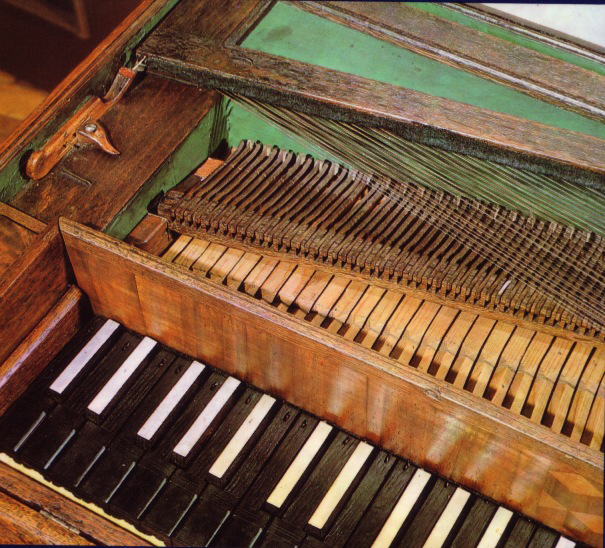
Frankfurt an der Oder: anonymous Tafelklavier (a Pantalon with two hammers for each note), ascribed by Herbert Heyde to the Magdeburg region c.1775. Significantly, it has no dampers, but the down-bearing harp stop (a semi-mute to imitate gut strings) is seen at the top, with a lever at the left to raise or lower it. A curious feature is the compressed geometry of the keyframe, resulting in the balance pins being visible in front of the 'nameboard' which its maker has not inscribed but skilfully inlaid with a parquetry decoration, now somewhat faded but visible lower right. Bottom left you can see the forward-falling lockboard [c.f. Zumpe, 1766]. Another example, so similar that it must be by the same maker, is in the Germanisches Nationalmuseum, Nuremberg, where it is, or has been recently on display. Its catalogue reference number is MINe 166. It makes a charming sound. [Note: Harding, 1933 p.51, Fig. 35 shows the action, but she fails to mention that it has no dampers, and misunderstands the alternate bare wood hammers stating that it is as a way of 'imitating the harpsichord'.]
Of course, the complete picture must include Pantalon keyboard instruments with only one set of hammers which were produced in large numbers in south Germany, usually with retro-oriented hammers. Most of them are unsigned and undated. It may be that some were made before 1766, but proof is wanted. A further difficulty is that Tafelklaviere of this type cannot be identified with certainty in eighteenth-century manuscripts because when an inventory cites a 'Pantalon' it is often impossible to decide whether it was a dulcimer, or a keyboard instrument shaped like a harpsichord, or a piano in upright form, as described by Jacob Adlung in 1758. More confusing still is the use of the word Pantalon to describe English square pianos, or copies of them, a noteworthy example being in the work of the Schmahl workshop in Ulm c.1790. With such seemingly insuperable difficulties in manuscript sources the search for the origins of square pianos is best confined to actual instruments. My suggestion made in The Pianoforte in the Classical Era (Oxford, 1998) and in the Galpin Society Journal [1997] is that the trail may lead to several independent originators or 'inventors' responsible for a wide variety of forms that appear to proliferate in the period 1760-1770. My own working hypothesis is that the earliest hammer-action instruments in rectangular form were probably damperless Pantalons made in northern Germany in the late 1750s, outwardly resembling clavichords, but having at least one mutation stop [likely to be a harp stop]. For more information of the Pantalon click here [opens another page on this site].
-----------------------------CONCLUSIONS -----------------------------
The history of the GRAND Pianoforte is not difficult to discover, beginning with Cristofori c.1700 in Florence and advancing slowly through the next hundred years in many European centres, but the advent of small, rectangular instruments that have become known as 'square pianos' seems to be a complex story.
John Zumpe, writing in London in 1780, claimed to be 'the inventor of the Small Piano-Forte' and no one is known to have challenged this. Perhaps the truth of Zumpe's claim may be restricted to the ubiquitous early type, known everywhere as the 'English Piano-forte' because it was first made in London (though chiefly by German-born craftsmen). Whether there were earlier examples made either in London or Germany is currently unproven.
A working hypothesis might be that the four types of square piano defined in my paper of 1997* may have been more or less simultaneous developments made independently in widely separated locations, all dating from the mid 1760s.
* Galpin Society Journal, pp.180-208.
----------------------------
Return to Michael Cole's Home Page.